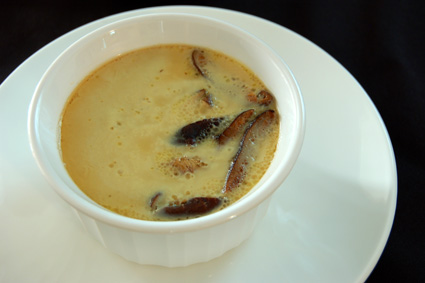
Custards are neat. I've mentioned it before, but I find the structural potential of egg proteins absolutely amazing. Plus, I really like the flavor of a good egg - it's hard to go wrong with those from local, free-range birds - and the trick becomes thinking of new ways to incorporate them into a meal.
Not that eggs, essentially plain, aren't a regular feature around here. Poached, fried or scrambled, they tend to make a breakfast appearance at least once a week.
Custards, though, are a big step in elegance for minimal effort. Aside from taking extra care and time to prevent them overcooking, they're hardly any more difficult or complicated than scrambled eggs. Crème brûlée always surprises me with its enduring popularity, thought I suspect that it's because people don't realize how effortlessly simple it is. Then again, most people won't take the time or effort to make chocolate-chip cookies.
Dessert custards - the crème brûlée, the flan - are well and good every great once in a while, but they're rich and sweet. Quiche is more to my taste, being a pie and an egg custard all at once. But if I'm not in the mood for making a crust? There's always chawan-mushi.
Chawan-mushi's a savory Japanese egg custard, filled with vegetables and chicken or seafood. Because of the juices and fibrous material in the vegetables, the custard overcoagulates in places and accumulates pockets of the juices. Though this would be a disaster for crème brûlée, as Harold McGee notes, "the Japanese expect chawan-mushi to weep and treat it as a combination of custard and soup." It sounds odd, but is surprisingly good; even the unusual texture remains soft and smooth, with a custard so soft it's nearly liquid itself. And, unlike other custards, it's at its best when served hot.
I have two recipes for chawan-mushi in two different Japanese cookbooks, but they're quite similar. Both use about two cups' worth of dashi to three eggs1; both feature boiled gingko nuts, shiitake mushrooms and chicken. One also includes shrimp; the other is titled "Egg Custard with Chicken, Shrimp and Vegetables" but doesn't actually have any in the recipe. Granted, it's the one that actually came from Japan, Japanese Home Style Cooking, and it does suffer from the occasional minor translation error. But the recipe's spot-on.
Chawan-mushiThat all sounds well and good, except that I don't often have many of those ingredients around the house. Fortunately, the method is readily adaptable to whatever happens to be handy.
Serves four
Adapted from Japanese Home Style Cooking
IngredientsDirections
- 3 eggs
- 2 cups dashi
- 1 teaspoon kosher salt
- 1 teaspoon soy sauce, plus extra for marinade
- 1 teaspoon mirin
- 3 ounces chicken
- Sake
- 4 shiitake mushrooms
- ¼ cup water
- ¼ teaspoon sugar
- 8 boiled gingko nuts
- 1-inch slice of kamaboko (boiled fish paste)
- Mitsuba, for garnish
- Mix the salt, mirin and ½ teaspoon soy sauce with the dashi and set aside.
- Dice the chicken and sprinkle with soy sauce and sake; let marinate for at least fifteen minutes. Cut the kamaboko into four slices.
- Place the mushrooms, water, ½ teaspoon soy sauce and sugar into a pan; simmer until the mushrooms are tender. When done, cut into bite-size pieces.
- Whisk the eggs in a mixing bowl, blend in the dashi mixture, and strain through a fine-mesh sieve. Divide the chicken, mushrooms, kamaboko and gingko nuts evenly into four ramekins, and slowly pour the custard mixture overtop.
- Steam the custards - either in a water bath or in a steamer basket - for fifteen to twenty minutes, or until set. Garnish with the mitsuba, and serve immediately.
The picture above is of a chawan-mushi made with duck stock and sauteed shiitake mushrooms; I'd been making duck confit and had a lot of carcass left over. Any meat, seafood or vegetable broth would fit the bill perfectly, and any tender - or cooked until so - vegetables or other ingredients would fit well inside. Do be sure to leave enough room for the custard, though - that smooth, soft texture is really a highlight of this dish.
Oh, and one more thing: The Oxford Companion To Food, interestingly, points out that chawan-mushi "is the only dish in the whole repertoire of Japanese cookery to be eaten with a spoon."
* * * * *
1McGee points out that three yolks per cup of liquid are necessary for a custard to be unmolded; the more eggs per unit of liquid, the firmer the custard. At half that ratio, chawan-mushi is a decidedly soft-textured custard.

No comments:
Post a Comment